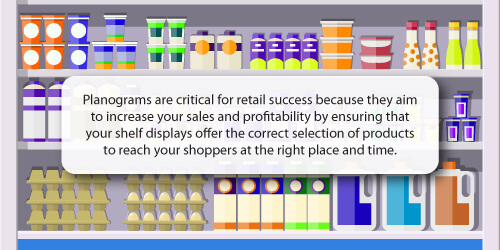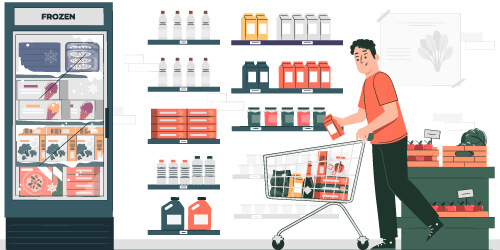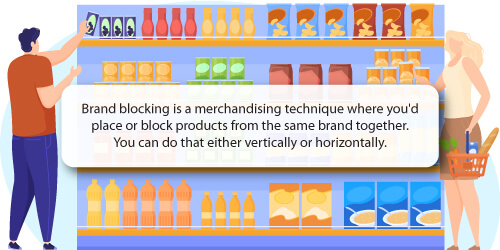Building a performance-enhancing planogram demands intricate category knowledge and access to critical elements. That makes it tricky if you’ve begun a new category project and don't know where to begin with merchandising. You might have a background in one category but need to work on a new one and are unfamiliar with the merchandising or space planning principles. If that's you, we have you covered.

We’ll take you through a few critical space planning principles to consider before you build a planogram. For this piece, we’re focusing specifically on food, general merchandise and category specialists such as Motor, Auto Spare Parts or Electrical.
Also, while there are many merchandising principles to consider, we've selected two per retail environment. It's worth noting that these are across multiple foods, general merchandise and specialist retail environments.

Fundamental space planning principles for food retailers
1. Give new products a minimum of two facings
How you portray your products to your customers on the shelf is one of the most important things to consider when building a planogram.
It is critical that all products on the shelf, regardless of their performance or Days of Supply (DOS), should have at least two facings. A product facing allows you to create the look of a perfectly stocked store by placing products on a display or shelf to the edge.
This principle is also especially vital when merchandising a new product.
Why? Because your customers aren't familiar with the new product, placing two or more next to each other grabs their attention. It enables you to create an eye-catching display. This also creates an opportunity for them to explore this product and could, in return, generate more sales on this new SKU.
By adding a minimum of two facings to a new product, sufficient exposure is given to the product so that the facings can be adjusted and aligned to the sales data once it is available.
2. Merchandise your high-performing products at eye level
If you fail to merchandise your products correctly, you stand every chance of losing out on potential sales from your top-performing items.
That's why this principle - placing high-performing products at eye level - is so critical. It improves the shopping experience because customers can find the products they want when they want them. Creating such an experience can lead to shoppers spending more time in your store browsing and adding items to their baskets than initially planned.
There is a well-known visual merchandising principle: “Eye Level is Buy Level”.
Eye level is the prime position on the shelf because it generates the most sales compared to the top or bottom of a shelf. This makes eye level the ideal area to merchandise top-performing products. It ensures a pleasant shopping experience and more sales and profit.
Not having the time or resources isn’t an excuse for not building data-driven planograms. If you’re in such a position - let us help you! When you book a complimentary consultation with us, we listen to you, so we can help deliver exactly what you need to succeed.
Some may disagree and state that you should place a popular product just above or below eye level as it would help sales because the customer would need to search for the item. As they search, they might add items to their baskets.
However, the opposite is also possible. And a more likely scenario. If busy shoppers need to search for products for longer than expected, that will frustrate them. They will also remember to avoid you the next time they have that particular item on their list. It only takes one bad shopping experience.

Fundamental space planning principles for general merchandise retailers
1. Merchandise house brands at the start of the aisle
In the past, low pricing and a lack of flashy branding meant house brands had a poor reputation. Customers often viewed them as inferior or of low quality. That reputation has since changed. In reality, more customers are choosing to buy these products over products from private labels.
Knowing this, it's worth merchandising your house brands at the start of the aisle.

When placing house brands here, you can ensure shoppers see these products first. They can evaluate your house brand, whether on the product offering or the price, before going to the next brand on the shelf.
Because house brands are merchandised similarly to your market leaders, shoppers are likely to compare these two products and could choose the house brand due to its competitive pricing.
For example, the market leader in the Garden Tools category and the house brand at an FMCG retailer might look almost identical. However, the product offering compared to the price makes the house brand a better option.
Thus, if you merchandise this house brand at the start of your aisle, shoppers will opt for these products, increasing its profitability and proving why it's a merchandising principle worth implementing in-store.
2. Apply brand blocking to the category
The shelf is often the first point of interaction that your customers have with a brand. Therefore, brand blocking is a vital space planning principle to apply. This is especially true if you're a general merchandise retailer.
But what is brand blocking?

Because brand blocking creates a strong brand presence within a category, it can assist with increasing brand loyalty. If a shopper is familiar with a brand, they'll walk to the relevant category, look at where you've placed the brand on the shelf and put it in their basket. That's without comparing this product with others.
Why? It's because they could identify the brand and product on the shelf easily. You also helped foster brand loyalty for this product due to consistent brand blocking.
But it's not just a method you can use on the shelf. Brand blocking is also an effective merchandising technique to apply at your point of sale area. Blocking a brand at your point of sales area helps it to stand out. Imagine customers rushing through their shopping and then waiting in line to pay and they came across such a display. When done correctly, you can encourage impulse buying.
Colour blocking is another strong merchandising technique that you can use in-store. It allows you to use colour to support your merchandising efforts.

Fundamental space planning principles for specialist retailers
1. Merchandise smaller products above your large products
Apart from the actual product size, the weight of an item could influence whether or not your customers can lift a product off the shelf. That's why it's a good idea to merchandise smaller items on the shelves above your large products.
By placing smaller objects, such as tool accessories, above large projects like power tools, it's easier for shoppers to browse your products, remove them from the shelf to compare and inspect and add them to their baskets or shopping trolleys.
A practical example here is paint cans in a hardware store. If you were to merchandise the 25l buckets at the top of your drop (shelf) and the small tester bottles at the bottom, your customers would have no problem removing the tester bottles. However, they'd struggle to remove the 25l buckets, perhaps even avoiding it altogether.
There is also the point that if they injure themselves attempting to remove these heavy items off the shelf, you could be liable.
2. Planogramming baskets
For products in specific categories such as globes and electrical or even toys, many retailers merchandise these in a basket on the shelf. It's not the most visually appealing when compared to any of the other principles and techniques mentioned in this article. But you can still use them to grab the attention of your customers.
Consider the basket dimensions
The height of the front is not necessarily the same as the back of the basket. If these dimensions are not verified beforehand, it could cause space issues as hanging products could take up the space of the basket.
Consider the placement of your baskets
You shouldn't place your baskets at eye level. It's better to add them at the bottom of your drop. Why? It can help your customer when they shop in this category. Instead of looking through the basket, they can look down and into it, seeing what it holds.

Conclusion
The success of a chosen category links to the merchandising principles you choose and how well you implement them in-store. When you implement these and others, you can build planograms that lead to visually-appealing shelves. That helps you create good shopping experiences for your customers. More importantly, it helps you to drive more sales and profit for your business.
Are you looking for a category management solution that’ll empower you to build space-aware data-driven product layouts that reflect your merchandising strategies? Or perhaps you need category management services that'll deliver such planograms to you, to perfection, every time.
Book a complimentary consultation with a DotActiv expert here today and we’ll provide expert advice tailored to your unique circumstances.


